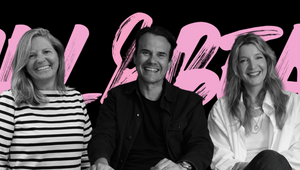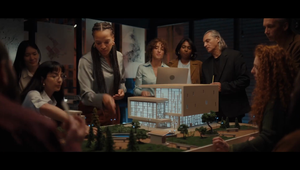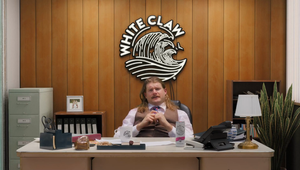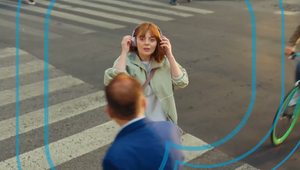
5 Minutes with… Robert Valdes

Girl&Bear, VCCP’s global content creation studio, has officially landed in the US – and it’s making a statement with the appointment of Robert Valdes as chief production officer.
A founding partner of FIG and former production leader at some of the world’s most progressive creative agencies, Robert joins at a pivotal moment of growth for both VCCP and Girl&Bear.
With a remit that spans nimble, social-first production, integrated craft, and tech-powered creative solutions, he’s charged with building a future-facing production model that can meet the demands of an industry in flux.
LBB’s Olivia Atkins talks to Robert about what drew him to Girl&Bear, why empathy is his North Star, and how AI, agility, and operational innovation can elevate the craft of production.
LBB> Your appointment at Girl&Bear US comes at a pivotal moment for the company’s US expansion. What drew you to this role, and how do you envision building a production offering that sets the tone for the market?
Robert> I think the industry is in a crucial moment where the convergence of so many outside forces is quickly shaping what the business will look like for at least a generation to come. I have been fortunate enough to not only work at great agencies, but also to have been at those places at pivotal moments in their history. All of that has allowed me to form a strong perspective on the different kinds of agency structures, sizes, approaches and the strengths and liabilities of each.
With all of that in mind, I knew I wanted to be at an independent shop. I also wanted to be at a place with enough scale and reach to navigate these times. But the most important thing to me was to find a place with the kind of spirit that would allow it to take advantage of the opportunities these crazy times offer, those who can see around the corner. VCCP, and Girl&Bear by extension, have all of those qualities. That was the ultimate draw for me.
That spirit is what I will use to build a US production offering that challenges the notion that in-house production is always inferior, always a threat to outside production partners, always a cash grab or always contributes to the commoditisation of craft and creativity. I know those are widely-held beliefs because I have spent much of my career having those beliefs. Girl&Bear was built to challenge that notion, so I envision building the US offering by drawing on the existing values of Girl&Bear and staring down those beliefs in myself to find the path through the challenges that can sometimes make those things true.
LBB> You’ve helped shape some of the most forward-thinking studios in the business – from Droga5 to FIG. How has your philosophy on production evolved, and what do you think production needs to look like in 2025 to stay truly ahead?
Robert> Over the years, I have come to have a lot of empathy for how nerve-wracking a production can be for anyone involved who is not a producer. Production can be a jarring change in the advertising workflow where things go from theoretical to very real, very fast. It's a time when decision makers are compelled to make choices that, in many cases, cannot be undone. That’s a lot for anyone – especially someone who doesn't spend every day in those circumstances.
That has led me to believe that the greatest responsibility of production is not to have the ability to bend reality to deliver, nor to have a prophetic grasp of new technology. I think the most important job is to be a thoughtful and faithful guide through the chaos for everyone involved. I believe we must view teams and clients' anxiety not as a threat or annoyance, but instead as information that, if we are open to it, can contain valuable insights.
That's what I think production needs to look like, not to stay ahead, but to stay human. When you focus on empathy rather than control, then you find yourself with the kind of openness that leads to thoughtful solutions, rather than the defensive posture of trying to preserve what has worked in the past.
LBB> With platforms constantly evolving, how do you approach the challenge of creating craft-led content that feels native to social and digital environments without compromising on storytelling?
Robert> I approach the evolution of platforms in the same way I always have – they are simply mediums. Like all mediums, they have strengths and weaknesses in how they touch an audience, what elements of craft matter and what facets of storytelling they can best convey. So, in the noise of ever-emerging platforms, the question remains the same; how do we produce this story in a way that takes advantage of this medium’s strengths?
LBB> You played a major role in launching FIG’s AI-powered platform StoryData. What’s your current take on how AI can responsibly enhance creativity in production rather than dilute it?
Robert> Every second that transpires between the moment a creative has that “ah-ha!” moment where they crack the idea, to the moment the work ships – that idea is dying. That is why it is imperative that, the moment inspiration hits, you start making work, not just ideating, but actually making work to keep momentum high and save the idea from the languishing death of a well-meaning process. That’s why I am such an advocate for prototyping, paper edits, motion tests and ad libs. You find out things about your idea once you start making it. Generative AI has become a really powerful tool that accelerates this practice and makes it more accessible. Beyond that, I think there are a lot fewer sexy, but equally important automation and quality of life enhancements that AI can bring to many facets of the job that if embraced, will all ladder up to better, more creative outcomes.
LBB> You’ve scaled teams at high-growth shops with very different cultures. What kind of talent mix and mindset do you think it takes to scale craft at speed while maintaining healthy creatives and without compromising quality?
Robert> There is a false equation in our industry that looks like this: money + talent = craft. While both of those things are important, the most overlooked aspect of craft is time. Time is the only non-fungible, non-replenishable resource whose impact on craft is always felt, but almost never discussed outside of production schedule conversations that miss the point.
Scaling craft at speed starts by prioritising smooth over fast. Creating an environment where focus and time are prioritised and staff is organised and incentivised to remove barriers from one another, rather than create them. The talent mindset has to be aligned. I want people who are, yes, talented, but also focused, disciplined, self-starters who understand that the more they use their time and their superpowers to make things easier for others on the team, the more the collective reservoir of time increases for all. This will always consistently elevate the level of craftsmanship coming out of your shop.
LBB> What’s something the industry still gets wrong about production today – especially in the US market – and how do you want to challenge or reframe that through your work at Girl&Bear?
Robert> That production is a function that starts after you have approved the creative. It is shocking to me how often the words ‘agile’ or ‘iterative’ are bandied about by places that wouldn’t dream of considering production relevant to a strategy or business conversation. Worse, many in the production community help perpetuate that belief with gatekeeping “you can’t do that” behaviour, or are all too willing to abdicate a role in other conversations by taking a “Let me know when you know what you want” attitude. I find that the most upsetting.
The kind of mind that can see through noise and land on a solution or the kind of person who willingly runs at a problem without a solution in hand, only the self confidence to know that they will figure it out when they get there, is what makes a great production person. Why wouldn't you want that kind of person in your next conversation? What solution might they bring to early-stage development work? What insight might they glean that later impacts the way the production is approached for the better? That’s something I am actively pursuing every day at Girl&Bear. I want to guide production people to open the aperture on how they see the ways that they can contribute and help those outside of production to see the value in those contributions.
LBB> As Girl&Bear ramps up in the US, what are your immediate priorities – and what kind of work or partnerships are you most excited to pursue in the next 12 months?
Robert> My first job is to build a production practice that meets the needs of our US clients. What is required in the US has changed almost overnight and production has to be reimagined here to meet those needs. That’s absolutely job one for me.
I am personally excited by activation work. VCCP is already really great at that type of work, but I would like to build on that already well-developed muscle to go bigger and bigger in that area.
Finally, it’s not the kind of thing that wins awards, but there is also a huge operational side to production that is incredibly important. There is a lot of opportunity for production operations innovation that brings a ton of value to clients and the staff. That all accrues to more focus, more time and better craft. Once Girl&Bear US is in fighting shape, I’m eager to dive into that and create better and better mousetraps that will benefit all of the Girl&Bear offices.















